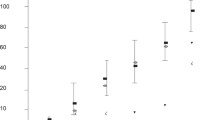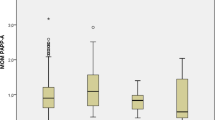Summary
PAPP-A is a macromolecular glycoprotein associated with human pregnancy. In vitro, PAPP-A is produced by explant cultures of trophoblast and decidua. The present work was undertaken to see if the presence of decidua had any effect on the disappearance rate of PAPP-A after removal of the placenta either by surgery or by spontaneous delivery. PAPP-A was measured before and at different times after a normal delivery (n = 6), after a termination of early pregnancy (n = 11) and after surgery for ectopic pregnancy (n = 8).
The half life of PAPP-A after normal delivery (52.9 ± 25.8 h, SD) was significantly (p < 0.03) less than after a first trimester termination (93.9 ± 41.6 h). After surgery for ectopic pregnancy in patients with curetted decidua, PAPP-A disappeared significantly faster (p < 0.005) then in patients with intact decidua (84.1 ± 17.8 vs 241.2 ± 81.5 h). These results indicate that PAPP-A continues to be produced by the decidua after removal of the trophoblast in early pregnancy.
Similar content being viewed by others
References
Bischof P (1979) Purification and characterization of pregnancy-associated plasma protein-A (PAPP-A). Arch Gynecol 227: 315–326
Bischof P, Haenggeli L, Sizonenko MT, Herrmann WL, Sizonenko PC (1981) A radioimmunoassay for the measurement of pregnancy-associated plasma protein-A (PAPP-A) in humans. Biol Reprod 24: 1076–1081
Bischof P, Rapin CH, Weil A, Herrmann WL (1982a) Is pregnancy-associated plasma protein-A a tumor marker? Am J Obstet Gynecol 43: 379–381
Bischof P, Lauber K, Wurstemberger B de, Girard JP (1982b) Inhibition of lymphocyte transformation by pregnancy-associated plasma protein-A (PAPP-A). J Clin Lab Immunol 7: 61–65
Bischof P, DuBerg S, Herrmann WL, Sizonenko PC (1982c) Amniotic fluid and circulating levels of pregnancy-associated plasma protein-A (PAPP-A) throughout pregnancy. Comparison with other foeto-placental products. Br J Obstet Gynaecol 89: 358–363
Bischof P, Geinoz A, Herrmann WL, Sizonenko PC (1983a) Pregnancy-associated plasma protein-A (PAPP-A) specifically inhibits the third component of human complement. Placenta (in press)
Bischof P, Meisser A, Haenggeli L, Reber G, Bouvier C, Béguin F, Herrmann WL, Sizonenko PC (1983b) Pregnancy-associated plasma protein-A (PAPP-A) inhibits thrombin induced coagulation of plasma. Thromb Res 32: 45–55
Bischof P, DuBerg S, Sizonenko MT, Schindler AM, Béguin F, Herrmann WL, Sizonenko PC (1984) In vitro production of pregnancy-associated plasma protein-A (PAPP-A) by human decidua and trophoblast. Am J Obstet Gynecol 148: 913–920
DuBerg S, Bischof P, Schindler AM, Béguin F, Herrmann WL, Sizonenko PC (1982) Tissue and plasma concentrations of pregnancy-associated plasma protein-A (PAPP-A). Comparison with other foeto-placental products. Br J Obstet Gynaecol 89: 352–357
Folkersen J, Westergaard JG, Hindersson P, Teisner B (1979) Affinity chromatographic purification of a new high molecular weight pregnancy specific protein SP4. In: Lehmann FG (ed) Carcinoma-embryonic proteins, Vol II. Elsevier/North-Holland, Biomedical Press, pp 503–508
Folkersen J, Grudzinskas G, Hindersson P, Teisner B, Westergaard JG (1981) Pregnancy-associated plasma protein-A: Circulating levels during normal pregnancy. Am J Obstet Gynecol 139: 910–914
Lin TM, Halbert SP, Kiefer D, Spellacy WN (1974) Three pregnancy-associated human plasma proteins: purification, monospecific antisera and immunological identification. Int Arch Allergy Appl Immunol 47: 35–53
Segel IH (1975) Biochemical calculations. John Wileys and Sons Inc., New-York London Sydney Toronto, pp 225–233
Sinosich MJ, Davey MW, Ghosh P, Grudzinskas JG (1982) Specific inhibition of human granulocyte elastase by human pregnancy-associated plasma protein-A. Biochem Int 5: 777–786
Smith R, Bischof P, Hughes G, Klopper A (1979) Studies on pregnancy-associated plasma protein-A in the third trimester of pregnancy. Br J Obstet Gynaecol 86: 882–887
Sutcliffe RG, Kukulska-Langlands BM, Coggins JR, Hunter JB, Gore GH (1980) Studies on human pregnancy-associated plasma protein-A. Purification by affinity chromatography and structural comparison with α2-macroglobulin. Biochem J 191: 799–809
Author information
Authors and Affiliations
Rights and permissions
About this article
Cite this article
Bischof, P., Amaudruz, M., Weil-Franck, C. et al. The disappearance rate of Pregnancy-Associated Plasma Protein-A (PAPP-A) after the end of normal and abnormal pregnancies. Arch. Gynecol. 236, 93–98 (1984). https://doi.org/10.1007/BF02134005
Received:
Accepted:
Issue Date:
DOI: https://doi.org/10.1007/BF02134005




